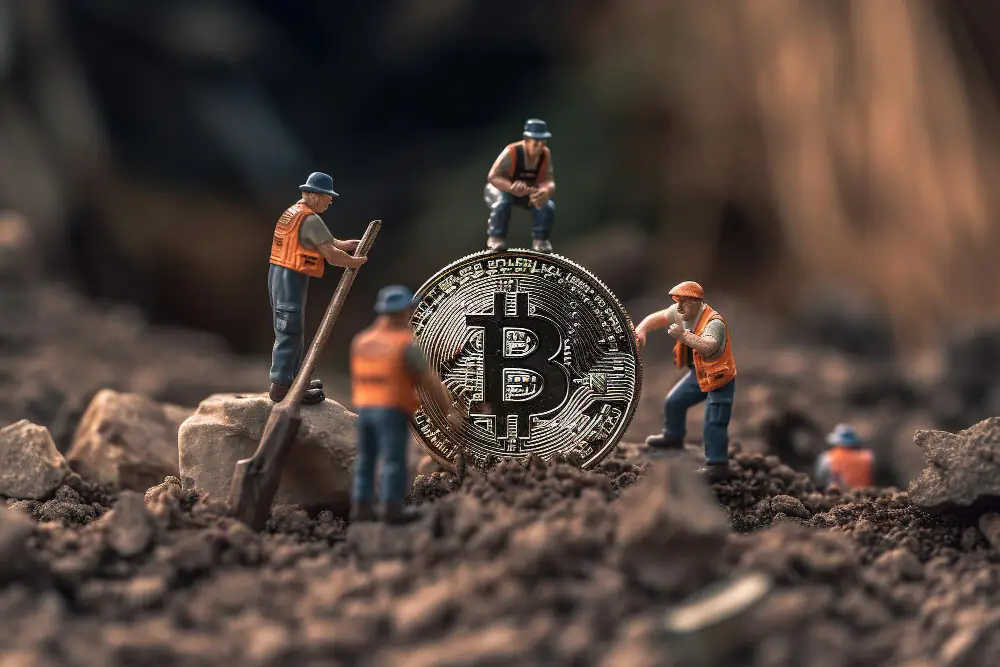Bitcoin mining is the fundamental process that enables the creation of new blocks of this decentralized cryptocurrency. But what exactly does Bitcoin mining entail, and how long does it take to mine 1 Bitcoin? PlasBit is passionate about informing and educating our users through our educational blog and tools. Therefore, we will explore the basic concepts of Bitcoin mining and delve deeper into understanding this vital activity in cryptocurrencies fully. Bitcoin operates on a technology called blockchain, which serves as a public and immutable ledger of all transactions made on the network. Mining is the mechanism through which transactions are confirmed, validated, and new Bitcoins are introduced into the system. To better grasp Bitcoin mining, it is essential to understand the concept of the blockchain. The blockchain consists of blocks, which are groups of transactions. Each block contains a set of transactions verified by miners and accepted as valid. Once a block is completed, it is linked to the previous block in the chain, creating a continuous sequence of blocks that form the blockchain. Bitcoin miners play a vital role in the mining process. Miners use powerful specialized computers to solve complex mathematical problems to verify transactions and create new blocks. Unfortunately, this activity requires significant computational power, and the electricity needed to operate mining operations can be substantial. One of the key features of Bitcoin mining is competitiveness. Miners compete with each other to solve mathematical problems faster and be the first to create a new block. The first miner to successfully solve the problem is rewarded with a specific amount of newly minted Bitcoin and the transaction fees included in the block. However, the Bitcoin mining process is dynamic. The difficulty of the mathematical problems regularly increases to ensure that blocks are created approximately every 10 minutes. It means that as the computational power of the mining network grows, it becomes increasingly challenging for miners to solve the problems and receive rewards.
The Mining Process: From Blocks to Bitcoins
Once we understand the basics of Bitcoin mining, we must explore the step-by-step process of transforming blocks into coveted Bitcoins. We'll discover also by using a Mining Calculator tool! This chapter will examine the mining process and how it unfolds, shedding light on the intricate steps from transaction validation to creating new Bitcoins.
1. Transaction Verification
Miners begin by collecting and verifying pending transactions from the network. Next, these transactions are organized into a block, forming a candidate block for mining.
2. Building the Block
Miners utilize their computational power to solve a mathematical puzzle called the proof-of-work algorithm. This process involves repeatedly hashing the block's data until a specific pattern, determined by the difficulty level, is found. Once a miner finds the solution, they add the block to the network.
3. Block Propagation
The newly mined block is propagated across the network, allowing other nodes to validate the solution and add the block to their copy of the blockchain.
4. Consensus Mechanism
The network employs a consensus mechanism, typically Proof of Work (PoW) or Proof of Stake (PoS), ensuring agreement among participants. BTC currently relies on PoW, which requires miners to demonstrate computational work and compete to find the solution first.
5. Block Confirmation
As more miners validate the block's solution and add it to the blockchain, the transaction within the block becomes confirmed. The number of confirmations increases over time, enhancing the security and immutability of the transactions.
6. Block Reward
The miner responsible for successfully mining a block is rewarded with a predetermined amount of newly created Bitcoins. It serves as an incentive for miners to contribute their computational power and secure the network.
7. Transaction Fees
In addition to the block reward, miners also receive transaction fees associated with the transactions included in the block. These fees incentivize miners to prioritize transactions with higher fees, ensuring faster processing. Understanding the intricacies of the mining process is crucial in comprehending the time and resources required to mine one Bitcoin.
Factors Affecting Mining Time: Difficulty and Hashrate

How long does it take to mine 1 Bitcoin? The time it takes to mine one Bitcoin is influenced by various factors, with two key elements playing a significant role: difficulty and hash rate.
Mining Difficulty
Bitcoin's mining difficulty measures how hard it is to find a solution to the mathematical problem required to mine a block. The difficulty is adjusted approximately every two weeks to maintain a consistent block creation time of around 10 minutes. If more miners compete for blocks, the difficulty increases, making finding a solution and extending the blockchain more challenging. Conversely, if miners exit the network, the difficulty decreases to incentivize participation.
Hashrate
The hash rate refers to the computational power dedicated to mining on the Bitcoin network. It represents the number of calculations miners can perform per second. A higher hash rate implies a greater computational capacity, increasing the chances of finding a solution faster. In addition, miners with more powerful and efficient mining rigs can achieve higher hash rates, giving them a competitive edge in mining new blocks.
Mining Equipment
The type and quality of mining equipment used also impact the hash rate and, consequently, the mining time. Specialized hardware, such as Application-Specific Integrated Circuits (ASICs), is designed specifically for mining cryptocurrencies like Bitcoin. These devices offer superior performance to traditional CPUs or GPUs, significantly improving mining efficiency.
Energy Costs
Mining Bitcoin requires substantial electricity due to the computational power consumed by mining rigs. The cost of electricity can significantly affect mining profitability and, consequently, the time it takes to mine one Bitcoin. Therefore, miners in regions with lower energy costs may have a competitive advantage over those in areas with higher electricity expenses.
Mining Pool Participation
Many miners join mining pools to combine their computational power and increase their chances of earning block rewards. By pooling resources, miners can collectively solve mathematical problems and share the rewards based on their contribution. As a result, pool mining can lead to more consistent earnings, but the individual reward share may be smaller than solo mining.
Mining Hardware: Unveiling the Tools of the Trade
Mining hardware plays a critical role in the efficiency and success of Bitcoin mining operations. In this chapter, we will delve into the different types of mining hardware miners use, understanding their capabilities and how they contribute to the mining process.
CPUs (Central Processing Units)
In the early days of Bitcoin, CPUs were commonly used for mining. However, as the network's difficulty increased, CPUs became inadequate due to their limited computational power. While CPUs are not efficient for Bitcoin mining today, they can still be utilized for mining certain altcoins or as part of mining pool systems.
GPUs (Graphics Processing Units)
Graphics cards, or GPUs, gained popularity among miners due to their superior computational power compared to CPUs. GPUs excel in parallel processing, which is beneficial for solving the mathematical puzzles involved in mining. Miners often build mining rigs with multiple GPUs to maximize their hash rate and increase their chances of mining Bitcoin.
FPGAs (Field-Programmable Gate Arrays)
FPGAs are hardware devices programmed to perform specific tasks, including Bitcoin mining. As a result, they offer higher efficiency and performance than CPUs and GPUs, making them more suitable for mining. However, FPGAs require specialized knowledge and programming skills to configure appropriately, limiting their accessibility to experienced miners.
ASICs (Application-Specific Integrated Circuits)
ASICs are the current standard for Bitcoin mining hardware. These devices are designed to perform the calculations required for mining optimally. In addition, ASICs offer significantly higher hash rates and lower power consumption compared to CPUs, GPUs, and FPGAs. As a result, they have revolutionized Bitcoin mining, allowing miners to stay competitive in the increasingly challenging mining landscape.
Power Consumption and Cooling
Mining hardware generates substantial heat and consumes significant amounts of electricity. As a result, miners need to consider adequate cooling solutions and factor in the cost of energy when selecting mining equipment. Efficient cooling systems and mining facilities are crucial to maintain optimal performance and profitability. Choosing the proper mining hardware is crucial for miners aiming to mine Bitcoin efficiently. The evolution of mining hardware, from CPUs to ASICs, reflects the growing demand for increased computational power and energy efficiency.
PlasBit Mining Calculator
In addition to our wallets and crypto debit cards, which offer the ability to convert and spend your crypto for daily expenses and withdraws, we also provide several tools, such as our Mining Calculator. This crypto calculator considers various factors such as hash rate, mining difficulty, electricity costs, and hardware efficiency. So how long does it take to mine 1 Bitcoin? Using our calculator, you can discover it quickly!
Understanding Mining Calculator
Our Mining calculator provides miners with valuable insights by utilizing relevant data to estimate the time it would take to mine one Bitcoin. It is an indispensable tool for anyone mining Bitcoin or planning to start. By inputting variables, miners can estimate the time required to mine a Bitcoin and evaluate the profitability of their mining operation.
Hashrate and Difficulty
Mining calculators consider the miner's hash rate and the current mining difficulty. Having robust and up-to-date hardware equipment is essential to have more chances to solve math problems, create new blocks, and receive more Bitcoins through rewards and fees. Mining calculators consider these factors to estimate the time needed to mine one Bitcoin.
Electricity Costs
Our mining calculator allows miners to factor in their electricity costs, significantly affecting their profitability. By inputting the cost per kilowatt-hour (kWh) and the power consumption of their mining equipment, miners can calculate the expenses associated with electricity and assess their impact on potential earnings.
Hardware Efficiency
Our mining calculator allows miners to specify the efficiency of their mining hardware, typically measured in terms of energy consumed per hash rate. This information helps estimate the mining output and the time required to mine one Bitcoin accurately. As a result, miners with more efficient hardware can expect higher returns and potentially mine Bitcoins faster.
Profitability Analysis
Our mining calculator provides an overall profitability analysis by considering the estimated time to mine one Bitcoin and the associated costs. As a result, miners can assess their potential earnings and determine if their mining operation is financially viable. This calculator also offers the flexibility to modify input variables and evaluate different scenarios to optimize mining strategies.
Conclusion
In conclusion, how long does it take to mine 1 Bitcoin? The time it takes to mine 1 Bitcoin can vary based on several factors. These include the mining hardware's hash rate, the current mining difficulty, the electricity costs, and the efficiency of the mining setup. To get a more accurate estimation of the time it would take to mine 1 Bitcoin based on your specific mining setup, you can use our mining calculator that considers variables such as hash rate, difficulty, electricity costs, and hardware efficiency. Given your circumstances, this calculator can provide valuable insights into the expected timeframe for mining 1 Bitcoin.







